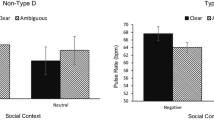Abstract
This study investigated the dimensions of normal personality style associated with psychological reactance. Participants consisted of 326 graduate and undergraduate students. They took the California Psychological Inventory—Revised, the Therapeutic Reactance Scale (TRS), and the Fragebogen zur Messung der psychologischen Reactanz (Questionnaire for the Measurement of Psychological Reactance). Results showed that the reactant individual has a personality style characterized by having a lack of interest in making a good impression on others, being somewhat careless about meeting obligations, being less tolerant of other's beliefs, resisting rules and regulations, being more concerned about problems and worried about the future, and being more inclined to express strong feelings and emotions. Separate analyses by sex on the TRS suggested that reactant women had a personality style that was more decisive, more sociable, and more self-assured than nonreactant women. Conversely, reactant individuals tended to be more concerned with problems and the future than did nonreactant individuals, although this difference did not appear for the subsample of women only.
Similar content being viewed by others
References
Beutler, L. E. (1979). Toward specific psychological therapies for specific conditions.Journal of Consulting and Clinical Psychology, 47, 882–897.
Brehm, J. W. (1966).A theory of psychological reactance. New York: Academic Press.
Brehm, S. S., & Brehm, J. W. (1981).Psychological reactance. New York: Academic Press.
Cooley, W., & Lohnes, P. (1971).Multivariate data analysis. New York: Wiley.
Courchaine, K. E. (1993).The role of client reactance on counselor social influence and the therapeutic alliance. Unpublished doctoral dissertation, Kent State University.
Dowd, E. T., Hughes, S., Brockbank, L., Halpain, D., Seibel, C. & Seibel, P. (1988). Compliance-based and defiance-based intervention strategies and psychological reactance in the treatment of free and unfree behavior.Journal of Counseling Psychology, 35, 363–369.
Dowd, E. T., Milne, C. R., & Wise, S. L. (1991). The Therapeutic Reactance Scale: A measure of psychological reactance.Journal of Counseling and Development, 69, 541–545.
Dowd, E. T., & Wallbrown, F. (1993). Motivational components of client reactance.Journal of Counseling and Development, 71, 533–538.
Garfield, S. L. (1978). Research on client variables in psychotherapy. In S. L. Garfield & A. E. Bergin (Eds.),Handbook of psychotherapy and behavior change (pp. 191–232). New York: Wiley.
Gough, H. G. (1987).California Psychological Inventory administrator's guide. Palo Alto, CA: Consulting Psychologists Press.
Graybar, S. R., Antonnucio, D. O., Boutilier, L. R. & Varble, D. L. (1989). Psychological reactance as a factor affecting patient compliance to physician advice.Scandinavian Journal of Behavior Therapy, 18, 43–51.
Horvath, A. O., & Goheen, M. D. (1990). Factors mediating the success of defiance- and compliance-based interventions.Journal of Counseling Psychology, 37, 363–371.
Jackson, D. (1984)Personality Research Form manual (3rd ed.), Port Huron, MI: Research Psychologists Press.
Jahn, D. L., & Lichstein, K. L. (1980). The resistive client: A neglected phenomenon in behavior therapy.Behavior Modification, 4, 303–320.
Lambert, M. J. (1991). Introduction to psychotherapy research. In L. E. Beutler & M. Crago (Eds.),Psychotherapy research: An international review of programmatic studies (pp. 7–8). Washington DC: American Psychological Association.
Loucka, P. A. (1991). Client reactance and counselor interpretations: Do they make a difference? (Doctoral Dissertation, Kent State University, 1990).Dissertation Abstracts International, 52-01B, 522.
Mallon, K. F. (1992).A scale for assessing psychological reactance proneness: Reliability and validity. Unpublished doctoral dissertation, University of Nebraska—Lincoln.
McKay, J. K., Dowd, E. T., & Rollin, S. A. (1982). Clients' characteristics as mediating variables in perception of counselors' social influence.Perceptual and Motor Skills, 54, 523–526.
Merz, J. (1983). Fragebogen zur Messung der psychologischen Reactanz [Questionnaire for the measurement of psychological reactance].Diagnostica, Band XXIX 75–82.
Pedhazur, E. (1982).Multivariate regression in behavioral, research (2nd ed.). New York: Holt, Rinehart & Winston.
Rohrbaugh, M., Tennen, H., Press, S., & White, L. (1981). Compliance, defiance, and therapeutic paradox.American Journal of Orthopsychiatry, 51, 454–467.
Shoham-Salomon, V., Avner, R., & Neeman, R. (1989). You're changed if you do and changed if you don't: Mechanisms underlying paradoxical interventions.Journal of Consulting and Clinical Psychology, 57, 590–598.
Swoboda, J. S., Dowd, E. T., & Wise, S. L. (1990). Reframing and restraining directives in the treatment of clinical depression.Journal of Counseling Psychology, 37, 254–260.
Thompson, B., & Borrello, G. (1985). The importance of structure coefficients in regression research.Educational and Psychological Measurement, 45, 203–209.
Thorndike, R. (1978).Correlational procedures for research. New York: Gardner.
Tracey, T. J., Ellickson, T. L., & Sherry, P. (1989). Reactance in relation to difference supervisory environments and counselor development.Journal of Counseling Psychology, 36, 336–344.
Wallbrown F. H., & Jones, J. A. (1992). Reevaluating the factor structure of the revised California Psychological Inventory.Educational and Psychological Measurement, 52, 379–386.
Author information
Authors and Affiliations
Additional information
The authors wish to thank Dana Fisher Trau and Earle Donelson for experimental assistance. An earlier version of this article was presented at the 1993 convention of the American Psychological Association, Toronto. The fourth author is deceased.
Rights and permissions
About this article
Cite this article
Thomas Dowd, E., Wallbrown, F., Sanders, D. et al. Psychological reactance and its relationship to normal personality variables. Cogn Ther Res 18, 601–612 (1994). https://doi.org/10.1007/BF02355671
Issue Date:
DOI: https://doi.org/10.1007/BF02355671




